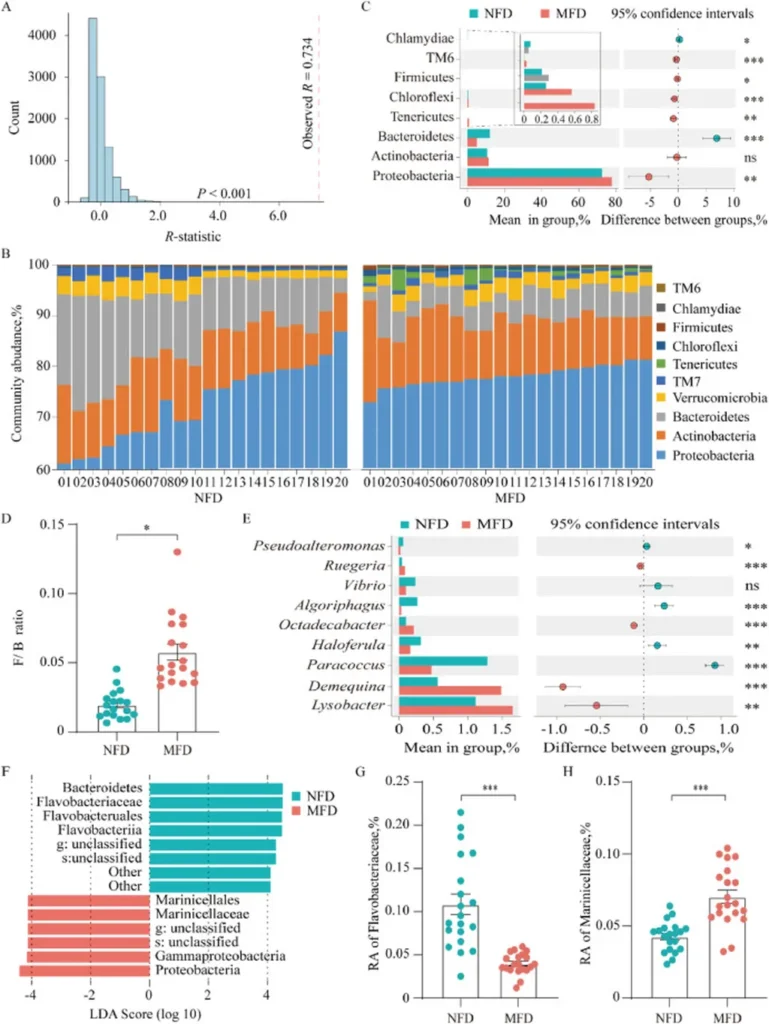In the quest to improve shrimp aquaculture, a recent study published in *Animal Nutrition* (translated from Chinese as “Animal Nutrition”) has uncovered promising results that could reshape the industry. Led by Yanbo Cheng from the Guangdong Provincial Key Laboratory of Microbial Culture Collection and Application and Guangdong Bide Biotechnology Co., Ltd., the research explored the impact of combining fermented feed with commercial feed on the survival and intestinal microbiota of Pacific white shrimp (*Litopenaeus vannamei*).
The study’s innovative approach involved creating a superior microbial community comprising *Enterococcus faecalis*, *Lactobacillus plantarum*, *Bacillus subtilis*, *Saccharomyces cerevisiae*, and *Aspergillus niger*. This community was selected based on its ability to enhance the nutritional quality of the feed. The researchers then prepared a low fishmeal (LFM, 15%) fermented feed and conducted a 56-day feeding trial with approximately 100,000 shrimp. The shrimp were divided into two groups: one receiving a high fishmeal (30%) non-fermented diet (NFD) and the other a mixed diet (MFD) with a 2:3 fermented to non-fermented ratio.
The results were striking. “Feeding the mixed fermented diet improved shrimp survival significantly,” Cheng noted, “but it did reduce yield and weight gain.” This trade-off presents a compelling narrative for the industry, as improved survival rates could offset the reduced yield, especially considering the long-term benefits of a healthier shrimp population.
The study also revealed that the mixed fermented diet did not increase ammonia nitrogen or nitrite content in the water, and in some cases, it even reduced these parameters. This is a crucial finding for the aquaculture industry, as high levels of these compounds can be detrimental to shrimp health and the environment. “The diet also modulated the intestinal microbiota, which is a key factor in shrimp health,” Cheng added.
The intestinal microbiota of shrimp fed the mixed diet showed a marked reduction in alpha-diversity indices, indicating a more stable and less diverse microbial community. At the phylum level, there was an increase in the relative abundance of Proteobacteria and a decrease in Bacteroidetes. This shift in microbiota composition could have significant implications for shrimp health and disease resistance.
The study’s findings suggest that the use of fermented feed could be a game-changer for the shrimp aquaculture industry. By improving survival rates and modulating the intestinal microbiota, this approach could lead to healthier shrimp populations and more sustainable farming practices. As the industry continues to seek innovative solutions to the challenges of shrimp farming, this research offers a promising path forward.
The implications of this research extend beyond the immediate findings. The modulation of intestinal microbiota and the improved survival rates could pave the way for further studies on the use of probiotics and prebiotics in shrimp aquaculture. This could lead to the development of new feed formulations that enhance shrimp health and productivity, ultimately benefiting the entire industry.
In conclusion, the study led by Yanbo Cheng and published in *Animal Nutrition* provides valuable insights into the potential of fermented feed in shrimp aquaculture. By improving survival rates and modulating the intestinal microbiota, this approach offers a promising solution to some of the industry’s most pressing challenges. As the field continues to evolve, this research will undoubtedly shape future developments and contribute to more sustainable and productive shrimp farming practices.

